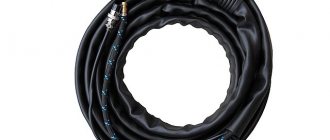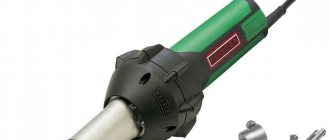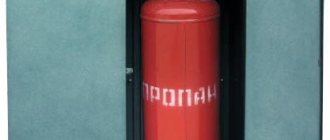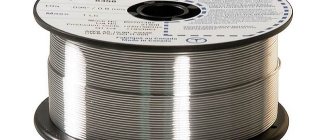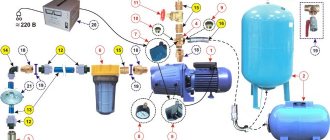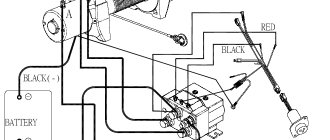1 / 1
For welding metals, the welding torch plays an important role along with the machine itself. The quality of the final result, the safety of the process and the level of productivity directly depend on it.
A semi-automatic torch is usually supplied complete with a welding machine. A good manufacturer immediately selects the best option. But this is a consumable that periodically wears out and requires replacement. Choosing a new one is complicated by a large number of nuances, which can be difficult to understand.
Why do you need a welding torch?
You can do without a torch unless you perform manual arc welding (MMA). In other cases, it is the welder’s main tool. It is used in all types of welding processes where gas is required:
- MIG/MAG (in a protective gas environment);
- TIG (argon arc);
- point method;
- gas welding;
- plasma cutting.
Its main purpose is to mix and supply protective or combustible gas to the working area, forming a stable flame. In this case, the combustion strength can be adjusted.
Torches for soldering with gas from a can
6th place – metal burner for a spray can
A very simple and narrow burner that fits onto a gas canister. The regulator and narrow nozzle allows you to get to the right parts in narrow places. There is no piezo ignition, but everything looks high quality - there is metal all around and a large gas supply regulator. A butane cylinder allows you to get a temperature of about 1300 degrees Celsius from this burner.
.
Advantages:
a lot of metal, narrow nozzle.
Flaws:
no piezo ignition.
7th place - a standard burner that fits onto a can
Positioned as a burner for tourists and cooking: barbecue, cakes, sushi, etc. Of course, it can be used for soldering, cutting and welding metals. Piezo ignition and flame regulator are present. The burner works classically with butane. The body is made of plastic, the nozzle casing is made of stainless steel.
The cost is like this.
Advantages:
well suited for cooking, has piezo ignition.
Flaws:
The body is made of plastic, so you need to be careful not to break it.
8th place – canister burner with a wide nozzle
The brass burner does not have piezo ignition, but it can fry barbecues and massive metal parts well. Orange Adjuster allows you to easily change the flame length. Butane from a cylinder heats the flame to 1300 degrees.
.
Advantages:
Well suited for cooking and massive parts.
Flaws:
no piezo ignition.
Understanding the device
Welding torches for each type of welding may have design features unique to them. But in general their device is identical: the burner itself (gander)
,
sleeve (train)
and
contact element
.
The gas welding tool is designed as simply as possible. On the back of the handle there are two fittings to which hoses are connected. The supply of gases is regulated by valves. There is a mixing chamber inside. The tip is attached to the handle by means of a union nut. And the design is completed by a mouthpiece through which the flame comes out.
A torch for a semi-automatic welding machine is distinguished by the fact that in addition to gas, current and welding wire are also supplied to it through a loop. Powerful devices have channels for liquid cooling.
Tool design
A torch for welding with propane gas consists of the following elements:
- lever;
- control valves;
- working chamber with a built-in injector (where the gas mixture is prepared);
- supply hoses connected to the body by means of special nipples;
- replaceable tips (they are installed on each of the hoses).
The hose chambers are marked with information regarding the type of tip and the composition of the gas that moves along this line. The valves on the burner are located in such a way as to make the tool as convenient to use as possible. As a rule, the worker holds it with his right hand and performs the necessary actions with his left.
As for the tip of a standard gas burner, it includes a mouthpiece, an injector and a supply tube. The diameters of the internal cavities of the mouthpiece and injector are designed for the passage of specific gases (propane or oxygen).
The operating temperature in the jet torch zone reaches + 2300 degrees. Therefore, copper is usually used as a material for making mouthpieces. The fact is that copper parts have high thermal conductivity, surpassing their brass counterparts in this regard. This increases their cooling rate during the welding process.
Working principle of a welding torch
This equipment has a simple principle of operation: gases are supplied to the mixer through control valves, after which they exit under pressure through a nozzle. The burning gas flow must have a certain speed - 70-150 m/sec. Exceeding this value causes the flame to break away from the mouthpiece and die out. And if the gas speed is too low, the fire can spread inside the instrument, which can lead to an explosion. Therefore, it is important that combustion occurs in specified modes.
In devices such as MIG/MAG or TIG, the process of seam formation occurs not under the temperature influence of a flame, but through an electric arc. But gas is also present and serves to form a protective environment around the weld pool.
With or without an injector: how does it work?
There are two types of gas burners. Let's look at each of them in detail.
Burners without injector
Design of injection and non-injector burners.
These gas burners operate at high pressure, have a relatively simple design and are extremely efficient to use.
Here is the algorithm in which they operate:
- The necessary oxygen is supplied from the air through special rubber slots and a valve, after which it enters the mixer.
- The function of the mixer is to divide the total flow into small jets that enter the nozzle. In the same way, the flow enters a special valve.
- Mixing of gas with oxygen occurs through circulation to ensure that the output is as homogeneous as possible.
- The mouthpiece at the tip is usually made of durable metal, such as copper. The mixture, heated to a very high temperature, comes out through it. The outlet temperature will be even higher than the melting point of metals.
The technical requirements for these devices are simple and specific: the gas flow must be uniform and have a specific speed that can be controlled and very accurately.
An additional requirement applies to the mixture: it must burn completely. The speed of the gas flow must be sufficient to prevent the flame from spreading to the top of the device, which is very, very dangerous due to the high risk of explosion.
On the other hand, the speed of the hot gas flow should not be too high due to the risk of the flame detaching from the mouthpiece with its subsequent attenuation.
How to calculate the optimal gas flow exit speed?
There are several factors to consider:
- composition of the combustible mixture;
- diameter of the inner wall of the nozzle;
- technical device of the mouthpiece.
The average speed is in the range of 70 – 150 m/sec.
Burners with injector
Methane, oxygen or acetylene are used as combustible gases, which are pumped into the mixer using an injector. This is the technological feature of the injection family of welding torches.
Here's how the injector design works:
- Combustible gas is pumped into the mixing chamber by an injector.
- Oxygen comes from the cylinder there too.
- After entering the mixer, the gas is mixed with oxygen in the air.
- The resulting mixture flows through the pipe into the mouthpiece.
- The gas pressure from the mouthpiece must be at least 3.5 atmospheres.
Injection models have a significant technological drawback that must be constantly remembered: the mixture of combustible gas and oxygen is not constant, it changes its composition all the time. As a result, the flame of such a gas burner, by definition, cannot be even and stable.
Such gas burners are used very widely, despite the low pressure and rather complex design. They have a built-in cooling system, since due to the low pressure the nozzle and mouthpiece become very hot. Therefore, the most important point is to control the overheating of the chamber so that it does not explode.
Classification of welding torches
A properly selected welding torch allows you to perform metal welding as efficiently as possible and ensures the comfort and safety of the worker. To buy a tool specifically for your needs, you need to know its classification and design features. The external simplicity of these products is deceptive; If you dig deeper, an unprepared person may feel dizzy from the diversity of their species:
- With and without injector.
- Gas and liquid.
- Universal and specialized.
- Single-flame and multi-flame.
- Manual and machine.
- With different flame power.
In addition, for each type of welding (semi-automatic or manual feed of filler rod, MIG/MAG or TIG, gas welding) a device of a certain design is required. Therefore, before you go shopping, it is useful to familiarize yourself with the classification of equipment.
Gas-burners
According to the principle of operation, torches for gas welding are either injection or non-injector (diffusion), and also differ in the gas used and in power.
Power characteristics
The capabilities of a gas burner and its scope of application largely depend on its power. This indicator is regulated by GOST 1077-79, according to which equipment is divided into 4 types:
- Micropower (r1) – non-injector type burners with a fitting size M12x1.25. Used for welding metal with a thickness of 0.1 to 1 mm, as well as for soldering.
- Low power (r2) – injection and non-injector type burners with replaceable fittings (the most popular tips are sizes M12x1.25 and M16x1.5). This is a common option, well suited for home use and small workshops. The thickness of the welded products is from 0.3 to 10 mm.
- Average power (r3) – here it is also possible to use injection and non-injector mechanisms. Tip size M16x1.5. They cook metal with a thickness of 0.5-35 mm. Most often used in industrial settings.
- High power (r4) – only injection type burners with M16x1.5 fitting. Weld thick-walled structures from 40 to 85 mm.
Injectorless burners
Diffusion models are extremely simple in design. Oxygen and combustible gas are supplied to the mixing chamber with the same pressure through separate channels. Before entering the mixer, the flows are divided into several thin jets. This creates extra swirls and promotes better mixing. The resulting mixture rushes further and comes out of the tip.
Injectorless burners have their advantages: you can separately regulate the supply of each component, accurately changing the flame temperature at the outlet; high pressure is not required for operation. The disadvantages include incomplete combustion of gas and low efficiency, the risk of flame entering the nozzle with subsequent explosion of the holder.
Injection
In injection models, only oxygen pressure can be adjusted. It is fed into the mixing chamber at high speed past the openings for the entry of flammable gas. This creates a rarefied low-pressure zone, under the influence of which the flammable gas rushes into the mixer after the oxygen. And then the mixture comes out along the tip. Thanks to this, the components are mixed thoroughly, and combustion occurs at a higher temperature. The flame escapes from the nozzle at a higher speed, which prevents it from entering. The disadvantage is uneven combustion, due to the fact that it is impossible to accurately adjust the ratio of components.
Differences in gas used
Three different types of gas mixture can be used in the welding process. Each of them requires its own burner:
1. For acetylene welding. The main application is welding, soldering and heating of metals. Flame temperature is about 3200 °C. You can weld ferrous metals of small thickness. Working with high-quality alloy steel is also possible, but the quality will be low.
2. Propane-oxygen. Due to the low combustion temperature of propane (2000-2100 °C), it is difficult to cook ferrous metal with them, but it is possible if the material thickness is up to 3 mm and the quality of the connection does not matter. These torches are better suited for soldering using high-temperature solder.
3. For gas-air propane welding. These are injection-type burners for working with a propane-butane mixture. You won't be able to cook or solder with them. The main purpose is to heat non-metallic and metallic materials. For example, when laying a roof or heating pipes for their subsequent bending. They are divided into single-flame and multi-flame (with several nozzles).
Semi-automatic torches (MIG/MAG)
The MIG/MAG welding process is carried out with a fusible electrode in a shielding gas environment. The torch consists of three main elements: the working part - the gooseneck, the cable and the contact connector, which is used to connect to the welding machine. Wire, gas and electric current are supplied through the hose to the working part. The gander is shaped like a pistol with an activation button.
When choosing a torch for semi-automatic welding, a number of factors should be taken into account: amperage, hose length, type of cooling, ergonomics and ease of maintenance.
With the first parameter, everything is very clear; it is only important to know what maximum current your welding machine is designed for, and choose equipment in accordance with this indicator.
The length of the sleeve is selected based on your own preferences and objectives. Some people believe that an excessively long cable contributes to energy loss, preferring short ones. For others, on the contrary, the length margin is important for greater mobility.
The type of cooling can be air or liquid. The first is suitable for welding with low currents (up to 250 A). With more powerful welding machines, liquid cooling is preferable.
Everyone chooses ergonomics for themselves. It is important that the instrument fits comfortably in your hand and is well balanced.
The main load falls on the working edge of the burner. For ease of maintenance, the tip with nozzle and diffuser are removable. This makes it possible to work with wires of different thicknesses, making them easier to clean or replace.
For argon arc welding (TIG)
Argon welding also takes place in a shielding gas environment, but a refractory electrode is used, and the formation of the seam occurs due to the filler material. There is no need for a device for supplying the electrode; it is fixedly fixed in the center of the nozzle. The factors you should pay attention to when choosing are the same as in the case of a semi-automatic. In addition, there are valve TIG torches that allow you to control the gas supply. It is convenient if the torch for argon arc welding is equipped with a trigger, with which you can activate the gas supply at the required moment.
What is a gas burner?
Gas torches are indispensable assistants and tools for many types of gas-flame processing of metals - gas-oxygen welding, soldering, heating.
To choose the burner that is most suitable for your type of work, you need to at least understand a little about the variety of design features, as well as the functional and technical capabilities of gas burners. Most often, burners are divided into three main types according to the combustible gas used:
- Welding torches operating on an acetylene-oxygen combustible mixture;
- Welding torches operating on a propane-oxygen combustible mixture;
- Propane gas-air burners.
Rules for using welding torches
The first step is to clean the welded areas to ensure a better connection and select the appropriate filler wire. Next, the current strength and wire feed speed are pre-regulated on the welding machine. Afterwards the speed of the gas mixture is adjusted. This parameter is selected empirically or by selecting the built-in program. Now you can proceed directly to welding.
The torch and filler wire are directed to the beginning of the weld. As the weld pool forms, the torch moves forward. When making vertical seams, choose the direction from bottom to top. This will make it easier to control the process, and the surface after hardening will be less deformed. In this case, the gas supply should be approximately 30% higher compared to the horizontal process.
How to use a gas torch during welding?
Drawing of a welding torch.
Torches are excellent companions in automatic or semi-automatic welding processes. As you remember, with these methods the welding wire is fed automatically, without the help of hands.
Thus, with the help of these technologies it is possible to reach the most difficult to reach welding areas with minimal effort. An additional advantage is that virtually no slag or other debris remains. The seam is formed quickly and of very high quality.
This method also has disadvantages. These include the very expensive cost of both basic equipment and consumables. The entire structure is quite heavy and difficult to move.
Steps in action:
- First of all, the most thorough cleaning of the surfaces of the workpieces being joined: not an ounce of rust or any contamination. We clean it thoroughly - not with a cloth, but with a metal brush and attachments on a grinding machine.
- We degrease the same surfaces for subsequent tight fit of metal to metal.
- Activation of the gas torch with simultaneous activation of the electrode wire feed system to start the main welding process.
- Setting the optimal wire feed speed, which is determined by the nature of the metal and other input factors.
Before work, you need to check the integrity and functioning of the injector. This is easy to do: connect the oxygen hose to the nipple and raise the pressure in the device to the operating level.
When oxygen passes through the injection system, a vacuum must form in the combustible gas channel. You can check it with your finger: it will stick to the nipple hole. If so, connect and secure both hoses. After this, the mixture is ignited and the flame size is adjusted.
As soon as the welding is completed, the valve of the acetylene cylinder is closed. The oxygen tap is turned off only second. This shutdown procedure must be followed without fail. Otherwise, the flame may hit the acetylene hose directly, causing an explosion.
If you do everything correctly, all the risks are justified: the seam turns out reliable and durable.
https://youtu.be/Rz1zG_fjkAU
Important nuances
Working with gas requires a highly qualified welder, knowledge and compliance with safety rules. There are many nuances in the use of gas burners, here are the most important of them:
1. To start work, flammable gas is started first and only then oxygen. To extinguish the burner, it is the other way around: first, the oxygen is shut off, and then the flammable gas.
2. Gas burners are 2-stroke and 4-stroke. In the first case, to activate, you need to press and hold the start key. If you let go, the work stops. The operating principle of a 4-stroke torch is different: a short press of the button turns on the gas supply and activates the welding process; when pressed again, the gas stops flowing.
3. The diameter of the wire in the semi-automatic torch must exactly match the diameter of its guide inside the nozzle.
Mini soldering torches
1st place – mini gas burner with soldering attachment
Designed for both heating medium-sized parts and for contact soldering due to the heating of the tip from the flame. A kind of soldering iron without wires. The gas tank capacity is 8ml. The flame temperature when filling with butane reaches 1300 degrees Celsius, and the tip temperature – 450 degrees. The flame length is adjustable from 4 to 6 cm. The burner length is 13 cm and the diameter is 1.5 cm.
Advantages:
small and inexpensive, the refill is enough to solder several medium-sized parts, there is a nozzle for contact soldering, it is easy to refill.
Flaws:
no piezo ignition.
2nd place – gas micro burner
There is nothing in it except a tank with a filling valve and a nozzle with a gas supply regulator. The ZC57100 does not have piezo ignition and it is supplied unfilled, so you will also have to buy a gas cartridge - it will be suitable for lighters. In general, to solder two wires or heat heat shrink without a soldering iron, such a torch is enough. The burner is also about 20 cm long and weighs 43 g.
This is the cheapest burner you can find anywhere.
Advantages:
the cheapest, easy to refill.
Flaws:
small flame, the filling runs out quickly, there is no piezo ignition.
3rd place – mini gas soldering iron KVT XZ-1
This remarkable soldering iron from the gas powered brand features piezo ignition and comes in a case with a set of 4 soldering tips, a spool of solder, and a tip cleaning sponge. Thus, the declared power of the soldering iron for contact soldering is 137 W - this is a lot for a soldering iron with a length of 21 cm and a weight of 120 g. Electric soldering irons have never dreamed of such weight and size characteristics. This soldering iron is not positioned as a torch, but it can be used as a torch - the flame is pencil-type.
Everyone loves this one, which is why it ended up in 3rd place.
Advantages:
burner from a famous brand, easy to solder, set of components, good case, high heat output.
Flaws:
high price.
4th place – gas burner IRIS BARCELONA
This torch is not only designed for soldering, welding, repairing electronic devices and jewelry. The flame of this burner is of course adjustable. Can be charged with a standard lighter gas cylinder. The flame length reaches 3 cm. The operating time is about 20 minutes. The flame temperature reaches 1300 degrees Celsius. The length of the burner itself is exactly 20 cm.
The price is like this.
Advantages:
small size, piezo ignition, brand.
Flaws:
The length of the flame does not allow heating medium and large parts.
5th place – butane burner KVT X-220
It is positioned as a burner for construction and repair work. She looks very stylish. The knurled handle fits nicely in the hand. Has a piezoelectric flame ignition system. The capacity of the cylinder for highly purified butane is 22 ml. This amount of gas is enough for 110 minutes of continuous operation. The flame length is adjustable from 30 to 80 mm from a sharp wedge-shaped flame to a soft flame with yellow tongues. The weight was only 226 grams with a length of 14 cm.
.
Advantages:
a good option for desktop work, there is a stand, piezo ignition, and a comfortable handle.
Flaws:
It's bulky, you can't put it in your pocket, you can't fit it into a narrow place.
Right choice
Any work using gas is classified as dangerous. Therefore, it is very important to be careful when choosing gas welding equipment. Never neglect safety rules and choose equipment only from trusted manufacturers.
has won special respect among professional welders, thanks to the characteristics and quality of its products. Only durable materials that meet all modern requirements are used in production. On the website you can order welding torches and all related components at prices from the manufacturer. Delivery is possible not only for residents of the capital, but also for all regions of Russia.
The company's product catalog includes torches for semi-automatic machines, as well as for argon-arc welding, that meet the highest safety parameters. Qualified managers know all the nuances of working with welding equipment and are always ready to make sure that your purchase is as useful as possible.
Security measures
Considering the fact that the use of a gas torch leads to the appearance of voluminous high-temperature areas, during welding activities the following rules must be strictly observed:
- It is allowed to work with gas welding equipment only in special protective gloves;
- it is advisable to avoid prolonged visual contact with the jet core to avoid damage to the cornea of the eyes;
- Emergency fire extinguishing equipment must be available at the workplace;
- Do not start work if your hands or clothes are stained with oil (the reaction of lubricants and oxygen leads to rupture of the cylinder).
Propane and oxygen cylinders can be stored in special metal cabinets. Access to equipment must be limited.
Similar articles
- New gas cylinder or certified?
- Methods for insulating gas cylinders when placed outdoors
- Safe practices for transporting gas cylinders

